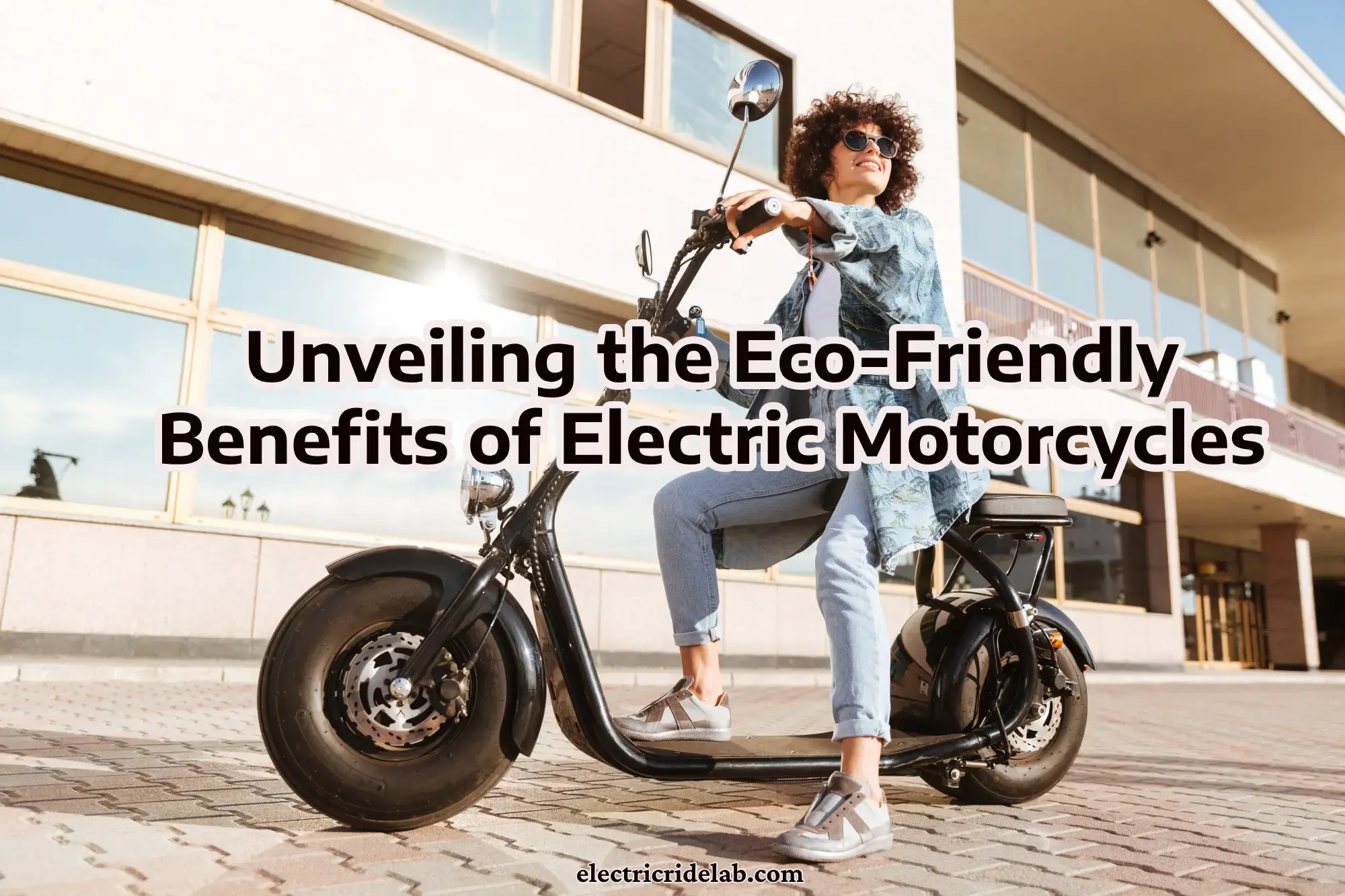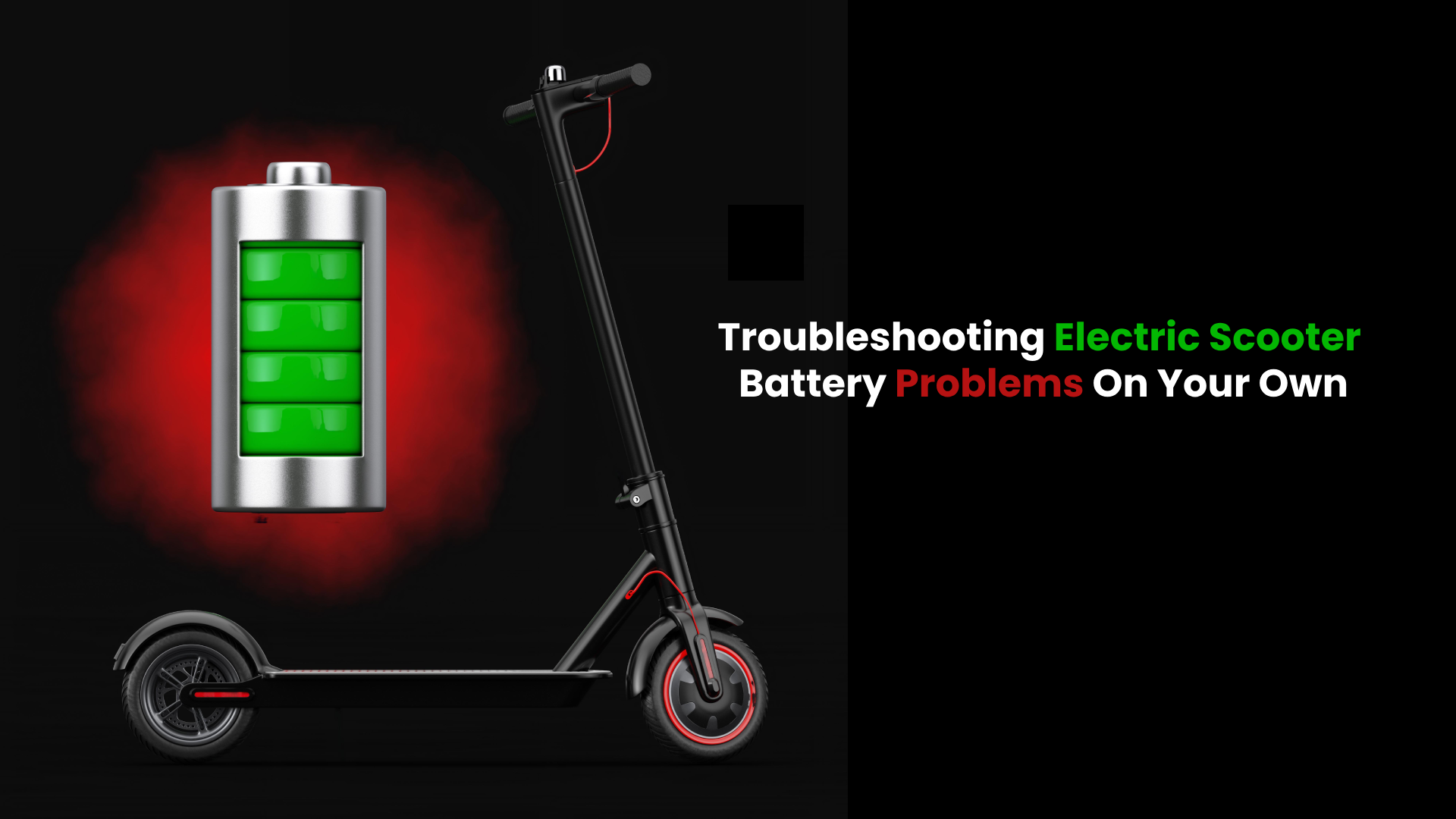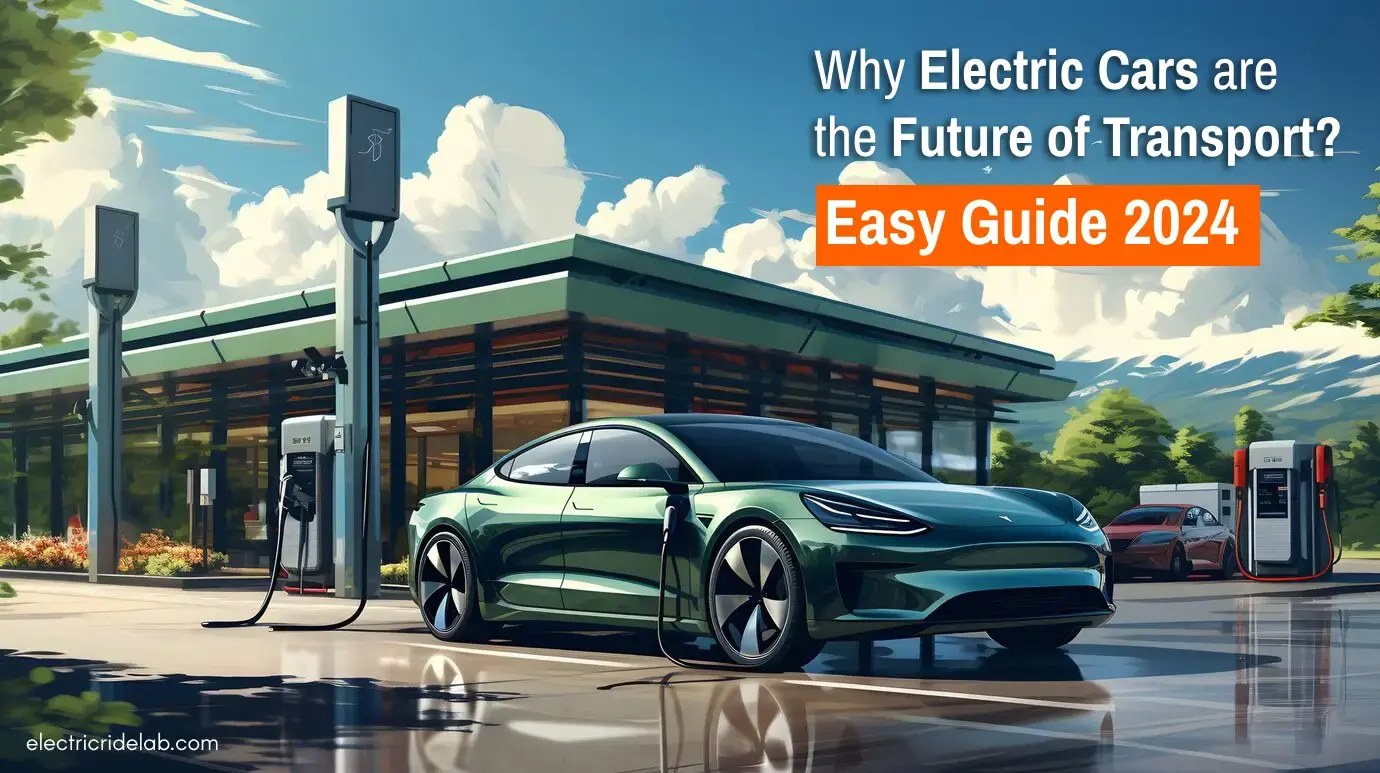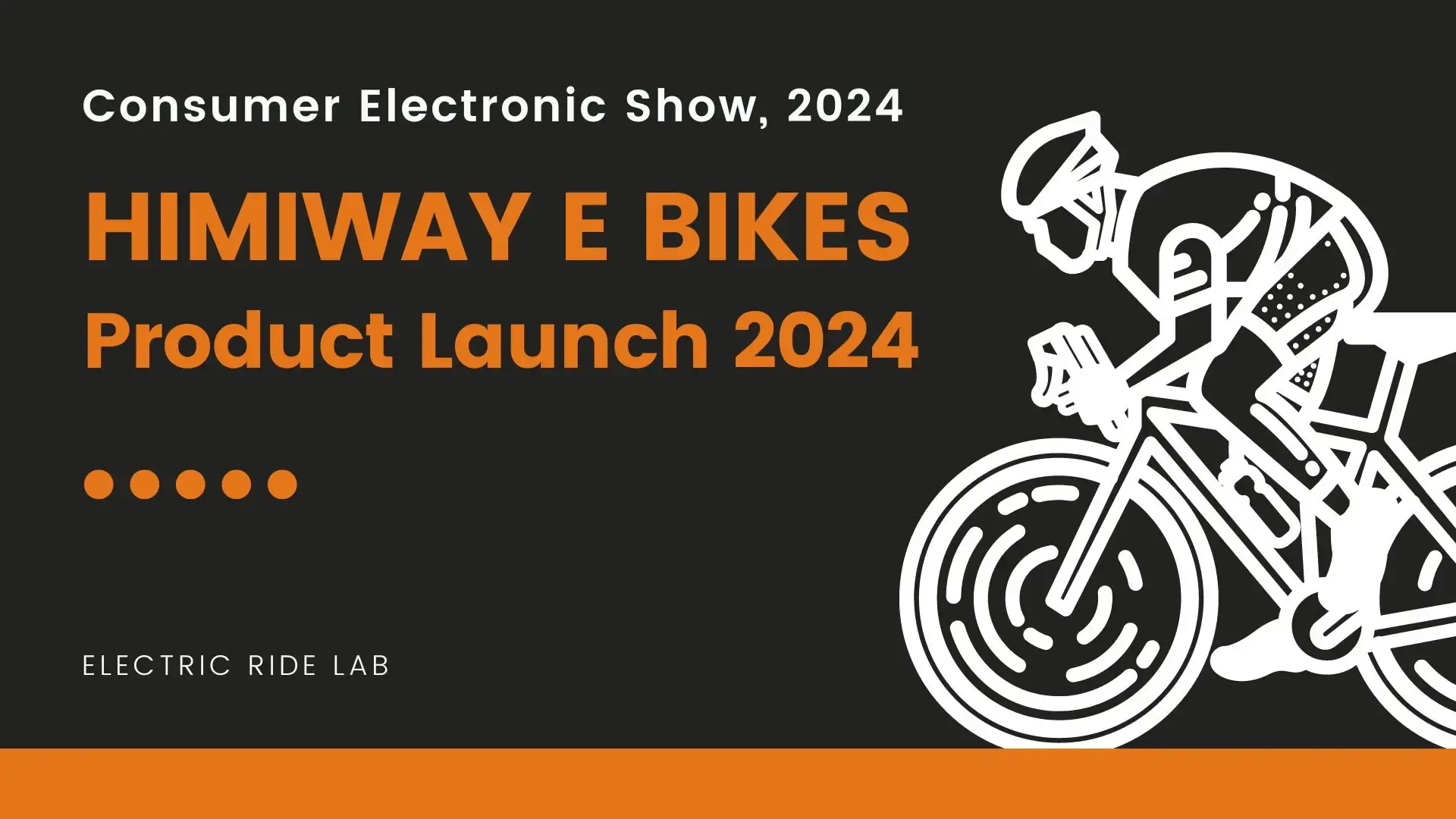There’s an electric bike for everyone. Yes, even for parents who want to go on a ride with their child.
As e-bikes skyrocket in popularity, manufacturers are rapidly pushing out different models designed for different needs. And if you’re a parent who wants to haul their little munchkin around, an electric bike with a child seat might be something you’re after.
To give you a hand, I’ve compiled a list of the best electric bikes with child seats and answered some questions to help you make an informed decision.
Editor’s 1st Choice
![RadRunner_Accessories Best Electric Bike with Child Seat in [current_date format='Y'] 1](https://www.electricridelab.com/wp-content/uploads/2021/03/RadRunner_Accessories.webp)
RadRunner 2
Overall Rating:
- Riders Weight Limit | 300 lbs (136 kg)
- Motor | Robust 750 W motor
- Range | Up to 45+ miles
- Battery | 48V, 14 AhLithium-Ion Battery
- Speed | 22 mph
Learn More!
![RadRunner_Plus_Closeups5_900x Best Electric Bike with Child Seat in [current_date format='Y'] 2](https://www.electricridelab.com/wp-content/uploads/2021/08/RadRunner_Plus_Closeups5_900x-300x200.webp)
![RadRunner_Plus_Closeups4_900x Best Electric Bike with Child Seat in [current_date format='Y'] 3](https://www.electricridelab.com/wp-content/uploads/2021/08/RadRunner_Plus_Closeups4_900x-300x200.webp)
![RadRunner_Plus_Closeups1_900x Best Electric Bike with Child Seat in [current_date format='Y'] 4](https://www.electricridelab.com/wp-content/uploads/2021/08/RadRunner_Plus_Closeups1_900x-300x200.webp)
![RadRunner_Plus_Closeups6_900x Best Electric Bike with Child Seat in [current_date format='Y'] 5](https://www.electricridelab.com/wp-content/uploads/2021/08/RadRunner_Plus_Closeups6_900x-300x200.webp)
![RadRunner_Plus_Right_Quarter_View_2400_900x Best Electric Bike with Child Seat in [current_date format='Y'] 6](https://www.electricridelab.com/wp-content/uploads/2021/08/RadRunner_Plus_Right_Quarter_View_2400_900x-300x200.webp)
Editor’s 2nd Choice
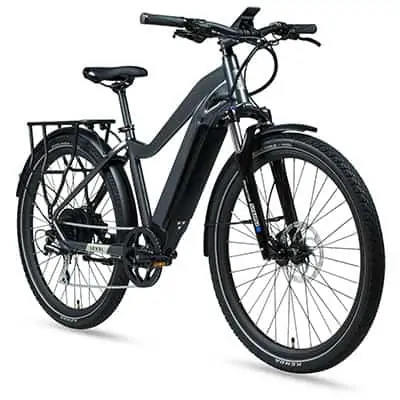
Aventon Level
Overall Rating:
- Riders Weight Limit | 300 lbs (136 kg)
- Motor | 750W (Peak) 500W (Sustained), 48V Brushless Rear Hub Motor
- Range | Up to 40 miles
- Battery | Removable Internal Lithium-ion 48V, 14Ah (672Wh)
- Speed | 28 mph
Learn More!
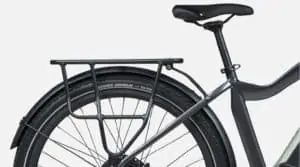
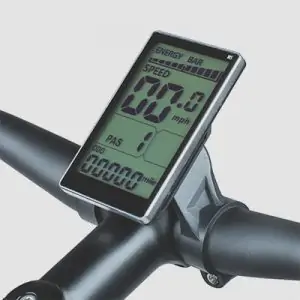
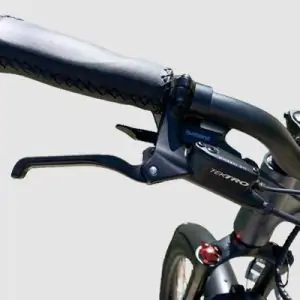
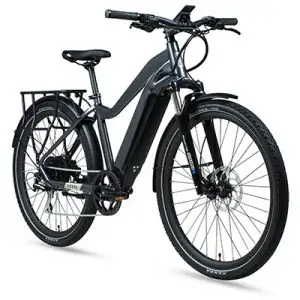
Editor’s 3rd Choice
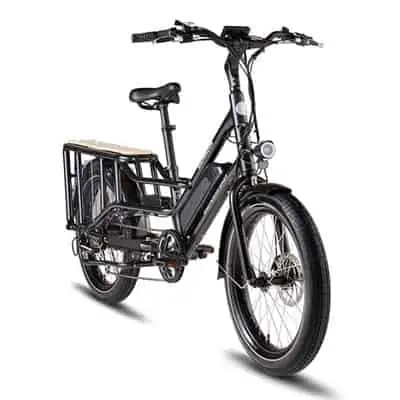
Radwagon 4
Overall Rating:
- Riders Weight Limit | 350 lbs (158 kg)
- Motor | 750W Geared Hub Motor
- Range | Up to 45+ miles
- Battery | 48V, 14 Ah Lithium-Ion Battery
- Speed | 20 mph
Learn More!
![Caboose Best Electric Bike with Child Seat in [current_date format='Y'] 7](https://www.electricridelab.com/wp-content/uploads/2021/08/Caboose-300x200.webp)
![Deckpad Best Electric Bike with Child Seat in [current_date format='Y'] 8](https://www.electricridelab.com/wp-content/uploads/2021/08/Deckpad-300x200.webp)
![RadWagon 4 Passenger Pegs Best Electric Bike with Child Seat in [current_date format='Y'] 9](https://www.electricridelab.com/wp-content/uploads/2021/08/RadWagon-4-Passenger-Pegs-300x200.webp)
![Running Boards Best Electric Bike with Child Seat in [current_date format='Y'] 10](https://www.electricridelab.com/wp-content/uploads/2021/08/Running-Boards-300x200.webp)
![Deckhand Best Electric Bike with Child Seat in [current_date format='Y'] 11](https://www.electricridelab.com/wp-content/uploads/2021/08/Deckhand-300x200.webp)
Also Related:
Got a Companion? Best Electric Bikes with Passenger Seat (Adult, Child or Dog)
1. RadRunner 2
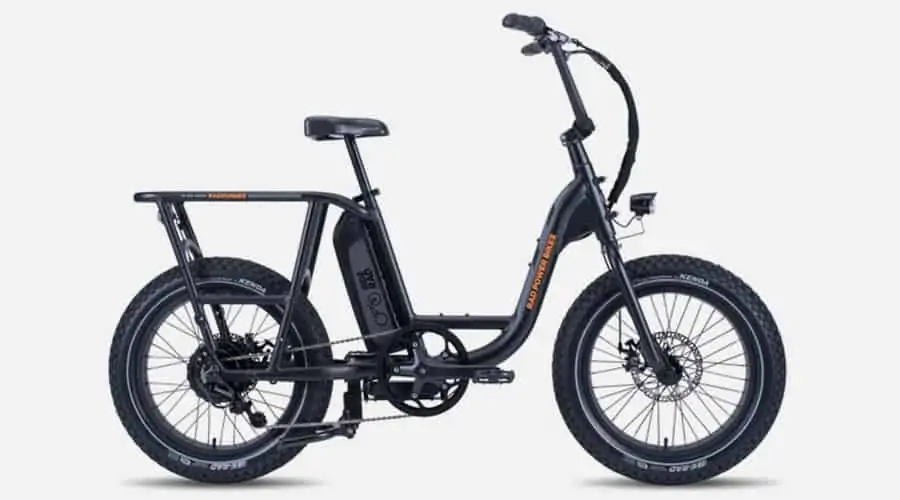
Riding with children and/ toddlers is not the same as traveling with a teenager or an adult. Because children are generally more naive than older individuals, extra precautions must be taken by riders to ensure their safety and comfort. Which brings us to an electric bike built with these considerations in mind; the RadRunner 2.
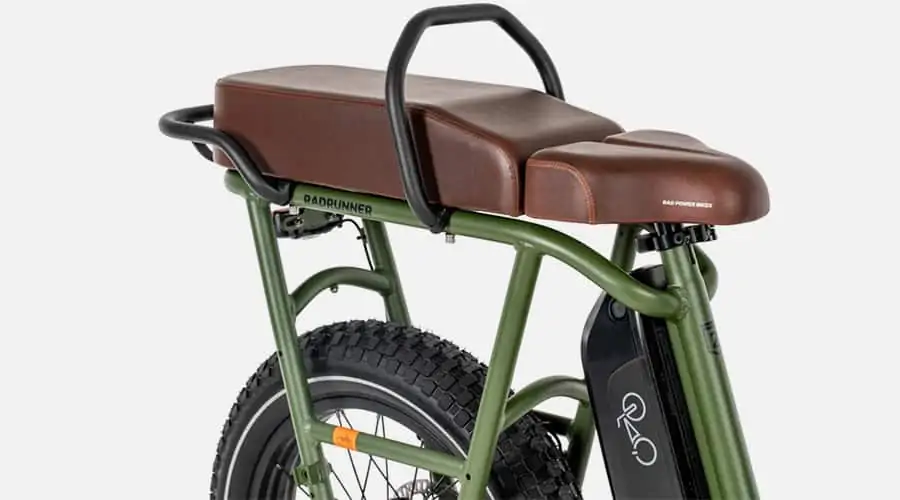
The RadRunner 2 is a customizable utility e-bike designed for heavy-duty purposes. Its frame is built to handle heavy payloads (up to 300 lbs/136 kg) and it also comes with a lot of accessories that make it passenger-friendly.
The e-bike’s integrated rear rack supports up to 120 pounds (54 kg) of weight, which is ideal for carrying even adults. Users also have the option to customize their bikes with 19-inch padded seats, dress guards, footpegs, etc. to make them even more passenger-friendly.
Riders looking to carry children under six years old should opt for safer child bike seats like the Thule Yepp Maxi. These types of seats are usually designed like traditional booster car seats but come with integrated footrests that can be adjusted to fit your baby’s tiny feet.
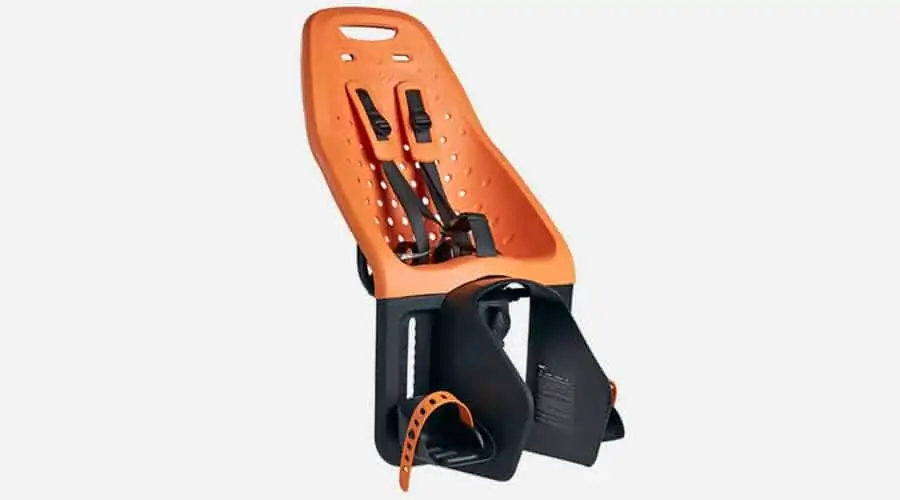
Image credit: Radpowerbikes.com
Another advantage of installing baby bicycle seats is they often come with harnesses that secure your child in place (kinda like your baby’s seatbelts). Now you don’t have to bother about your child getting thrown off the bike anytime you hit the brakes or go over large bumps.
Just in case you’re wondering how hard it is to mount a baby seat on the RadRunner 2; don’t fret! Most booster bicycle seats come with easy-fix clamps that fit around normal-sized rack tubes.
You won’t even need tools to fix such baby seats on the Radrunner 2. Just guide the seat’s locking mechanism into the rack’s tubing and turn the knob until it locks in place.
The YouTube video below shows how easy it is to mount and dismount the Thule Yepp Maxi.
Performance-wise, the RadRunner 2 ranks as one of the best utility e-bikes currently available on the market. It is equipped with a 750-Watt geared hub-motor and can cover up to 45 miles on a full charge.
Pros
- It has extra room for a front-mounted seat. Even if the e-bike’s rear passenger seat is occupied, riders can mount another seat in-between the stem and seat post. This way, no one gets left out of the fun.
- The Radrunner 2 is an affordable family e-bike. Each unit retails for about $1900, which is almost $100 cheaper than most mid-range cargo e-bikes available today. Rad Power also offers flexible payment plans on their official website.
Cons
- It is a stripped-down version of the Radrunner Plus. The Radrunner 2 is kinda like the basic version of the Radrunner Plus.
It doesn’t come with fenders nor is it equipped with safety accessories like footpegs & dress guards (all of which are pre-installed on the Radrunner Plus). - Rad Power could have done a better job with the brakes. Not that there’s anything wrong with mechanical disc brakes, in fact, some customers compare the RadRunner 2′ brakes to hydraulic disc brakes.
However, when it comes to efficiency, you really can’t compare a system that amplifies squeezing force to one that only transfers it. This is why you’ll find that most high-end e-bike manufacturers prefer to install hydraulic brakes on their bicycles.
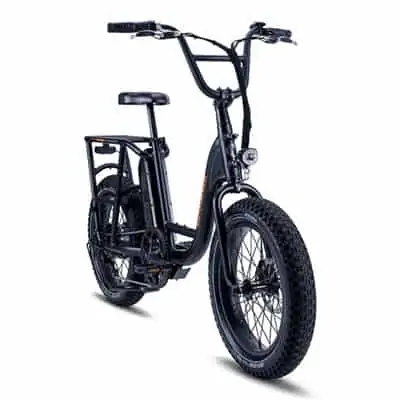
Main Features:
- Riders Weight Limit | 300 lbs (136 kg)
- Motor | Robust 750 W motor
- Range | Up to 45+ miles
- Battery | 48V, 14 AhLithium-Ion Battery
- Speed | 22 mph
Also Related:
Best Electric Bikes for Teens: Give Them Something Unique
2. The Aventon Level
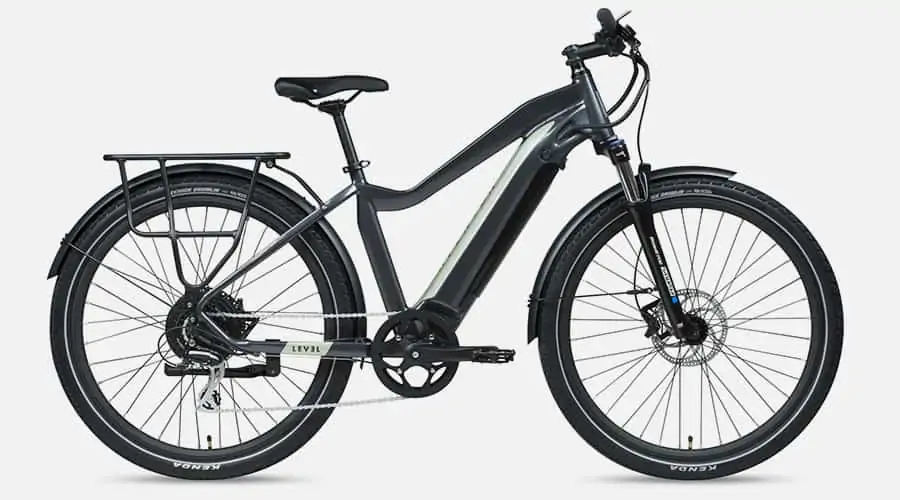
Aventon’s Level is a high-powered electric bike built for multiple use-cases. The bike comes with a rear-mounted rack built to support up to 50 lbs of weight.
This built-in rack can be used as a mount for padded seats or as a supporting structure for easy-fit baby seats. For riders looking to carry more than just one child per trip, the step-through version of the Level provides ample space to fix a front-mounted seat.
Just below the rack is a full-length fender designed to shield passengers from dirt and debris that usually spray off of the bike’s rear wheel. So, even if it’s wet outside, you can still take your baby out for a ride, rest assured that their clothes won’t be completely covered in streaks of mud after your trip.
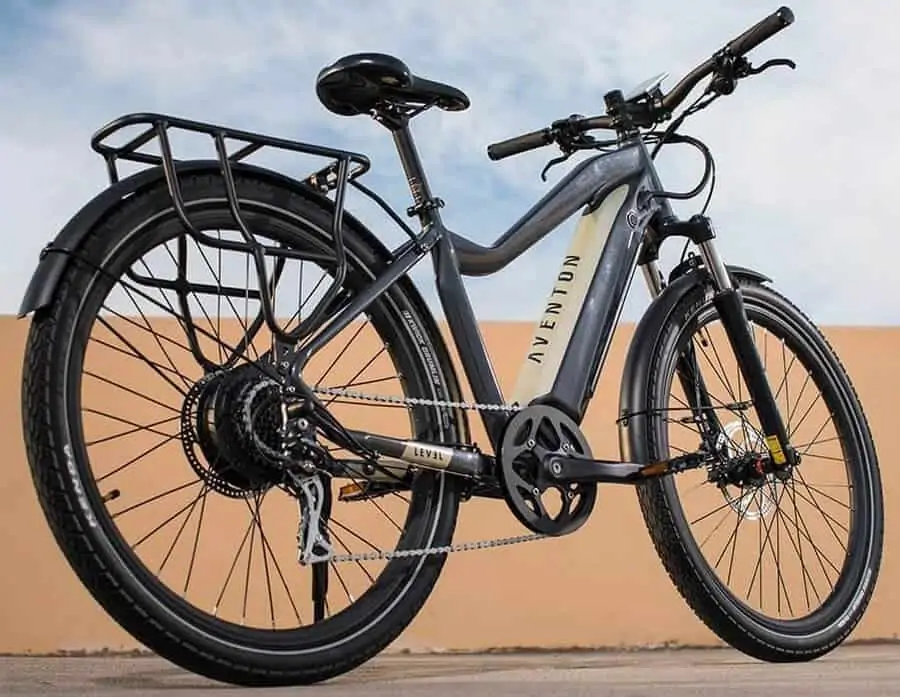
Aventon recommends not loading more than 300 pounds of weight on the Level, which sounds like a decent amount for a dual-passenger e-bike. Powering the entire unit is a 48V 14Ah lithium-ion battery estimated to be able to store 50 miles worth of charge for every full cycle.
The Aventon Level also comes equipped with a 500W rear hub motor that can put out up to 750 Watts of power at peak performance. Whether it’s a recreational ride at the park or a hilly commute to your child’s school, the Aventon Level meets the performance requirements for transporting more than one rider from one location to another.
Pros
- The Aventon Level is also suitable for light off-road riding. It comes fitted with adjustable front suspension forks that travel up to 75mm when compressed.
These forks will make off-road rides smoother and more comfortable for you & your child companion. They can also be locked out to meet the needs of riding on paved roads. - It has hydraulic disc brakes. As mentioned earlier, electric bikes with hydraulic disc brakes require less pressure at the lever to be brought to a stop.
A hydraulic disc brake will require less effort to produce the same amount of braking power as a mechanical system. Plus, they don’t need to be maintained as frequently as cable disc brakes.
Cons
- The e-bike doesn’t come with footrests nor mounts for footpegs. Your passenger will need somewhere to rest their legs if they’re going to be comfortable throughout the ride.
To make it worse, Aventon also skipped installing dress guards on the bike. . Read more about Aventon’s ebikes problems and drawbacks.. We all know how children can be; one minute they’re focused on enjoying the scenery and the next, they’re trying to figure out how quickly they can retract their legs from getting caught in-between the wheel’s spokes. - The bike’s rack is not as roomy as other e-bikes on this list. It’s small and doesn’t have as much storage space as the Radrunner 2 or the Radwagon 4.
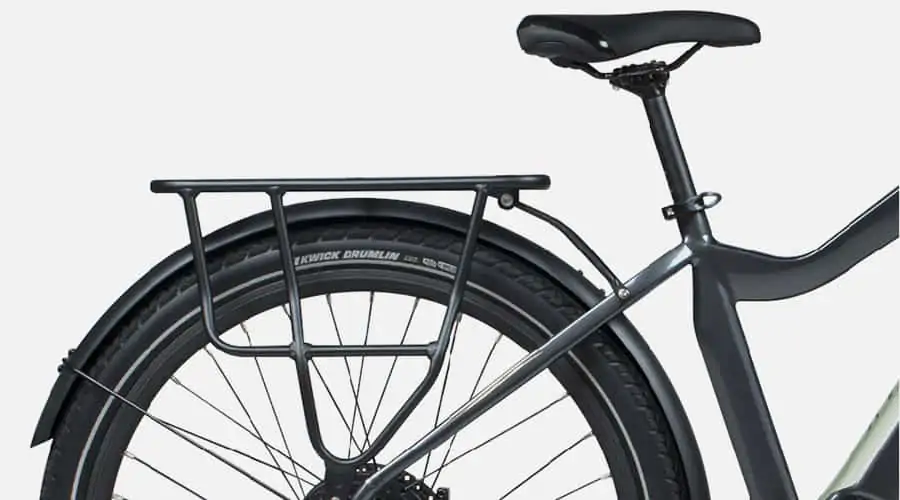
Image credit: Aventon.com
Also, I wouldn’t recommend loading children older than 6 years on the bike’s rack. It’s not frame-integrated and might not be as sturdy as the manufacturer claims.

Main Features:
- Riders Weight Limit | 300 lbs (136 kg)
- Motor | 750W (Peak) 500W (Sustained), 48V Brushless Rear Hub Motor
- Range | Up to 40 miles
- Battery | Removable Internal Lithium-ion 48V, 14Ah (672Wh)
- Speed | 28 mph
Also Related:
Pulling a Trailer? Here Are The Best Electric Bikes for Towing
3. Radwagon 4
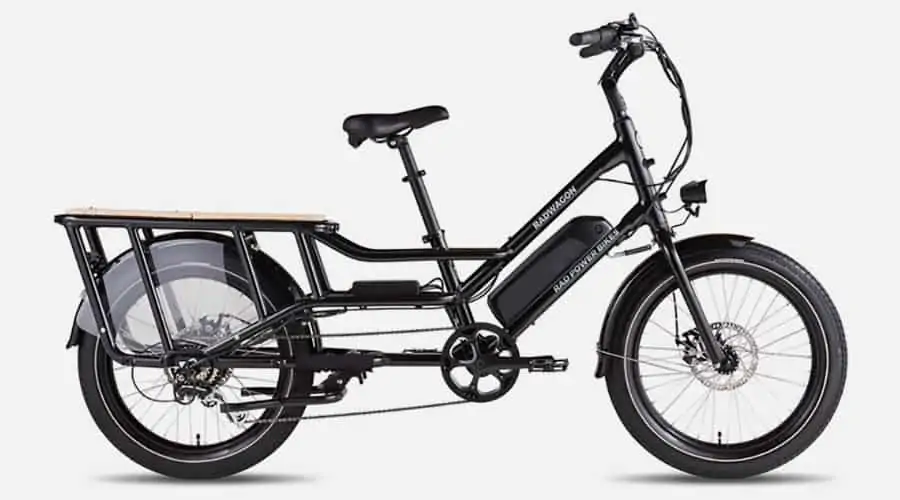
If you’re looking for an electric bike with 2 child seats, check out the Radwagon 4. The bike’s integrated rear rack measures up to 26 inches (6 inches longer than Radrunner 2’s) in length and is rated for a maximum weight capacity of 120 lbs (54 kg).
What really makes the Radwagon 4 stand out from other electric bikes on this list is its ability to adapt to the needs of riders. There’s room enough for two seats (a deckpad and/or a baby seat) to be mounted on the Radwagon 4’s rear rack.
Thanks to the bike’s adjustable seatpost, riders can also install front-mounted seats to create extra room for one more tiny passenger. The bike also provides an easy-fix solution for installing safety mechanisms around its rear rack. Utilizing this feature will ensure the safety of your children as you ride over bumps and engage the brakes.
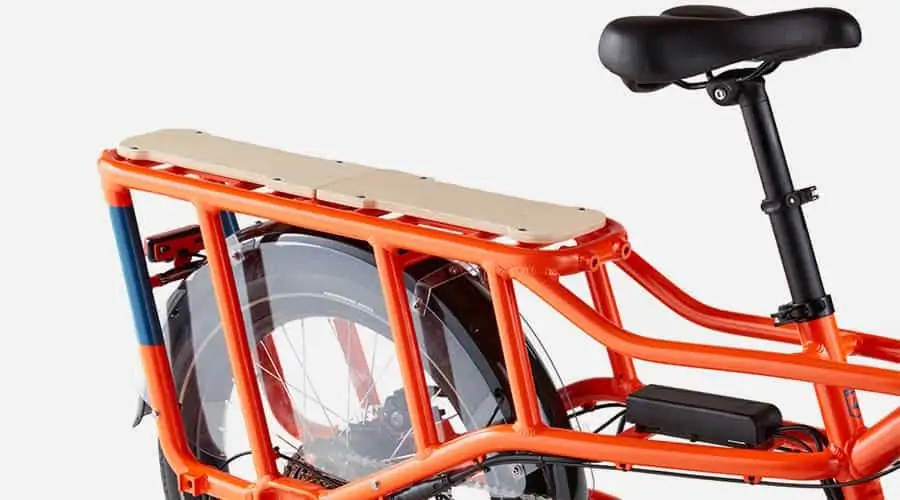
The recommended weight limit for the Radwagon 4 is 350 lbs (159 kg). Propelling all that weight is a geared 750W motor fitted into the bike’s rear wheel.
Pros
- It is one of the best cargo bikes for families. The Radwagon 4 can carry up to three passengers on a single trip.
Thankfully, you don’t need to pedal to ride the bike. Its half-twist throttle activates the bike’s motor on demand. - Their 22-inch tires provide better maneuverability than larger diameter tires. Not just that, because the bike has a lower center of gravity, riding on it should feel a bit more steady than riding on regular e-bikes
Cons
- Replacing any of the bike’s wheels (including the one without an integrated motor) won’t be easy. As mentioned earlier, the bike comes with 22-inch tires – a not-so-common tire size for bicycles.
They are so uncommon you might have to reach out to Radpower to order the same size tires. - The Radwagon 4 is a large electric bike. It weighs 76.7 lbs (34.8 kg) and has a total length of 77 inches.
Although it’s hard to find lightweight e-bikes that aren’t afraid to support a little extra weight, it is safe to conclude that the Radwagon’s weight is a little on the high end when compared to other family ebikes like the Tern GSD S10.

Main Features:
- Riders Weight Limit | 350 lbs (158 kg)
- Motor | 750W Geared Hub Motor
- Range | Up to 45+ miles
- Battery | 48V, 14 Ah Lithium-Ion Battery
- Speed | 20 mph
Is It Safe to Carry a Child in a Bike Seat on an Electric Bike?
Carrying a child on an electric bike’s seat poses no real risks to their wellbeing as long as you take the precautions necessary to ensure their safety. Below are a few pointers on how to keep your child safe while riding your e-bike.
- Always make sure you strap them in their seats before hitting the road. Generally, booster seats offer better protection for children under six years old than normal bench seats.
- Always maintain low speeds — below 15mph (24.14 kmh) — when traveling with a child passenger.
- Ensure whatever platform or mount the child’s seat is fastened to is designed for heavy-duty purposes. For example, if the weight capacity of an electric bike’s rack is 30 lbs, carrying a child heavier than that limit could damage the rack – hopefully it doesn’t completely fall off with your child on it.
- Consider installing guards around the area where you plan to mount the seat. Radpowerbikes offers one of such safety mechanisms on their ebikes. They call it the Caboose and it comes with adjustable inner rails.
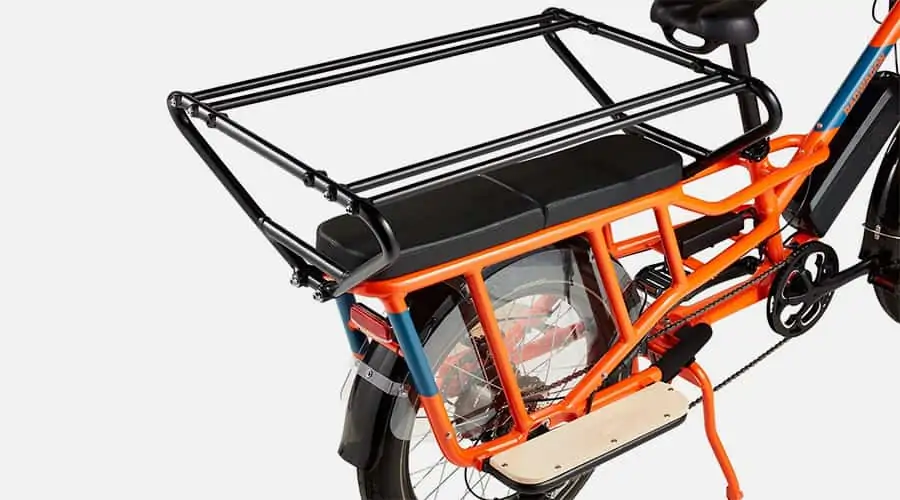
Image credit: Radpowerbikes.com
As a bonus tip, only ride electric bikes with high weight capacities. Also, if you can, purchase an electric bike with child carrier. It’ll save you the time and cost of installing accessories that’ll prepare your e-bike for dual-passenger riding.
Electric Bike with Child Seat
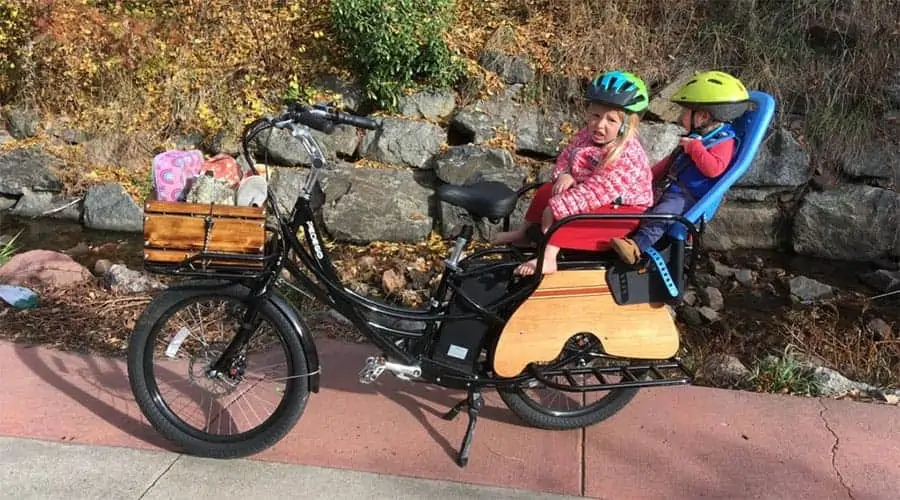
Now that we’ve learned the best carriers for babies and toddlers, let’s look at the children’s e-bikes.
They’re not so much different from the baby carriers, but here, preference isn’t paid too much to age and development, but rather on the mounting of the seat.
No products found.
You need to determine what type of seat system would suit your kid.
Generally, there’re three types of seat mounting systems, and each of them has its benefits and drawbacks.
1. Rear Seat
No products found.
The rear seats are the most popular types of seats in the market and suitable for kids aged between 12 months to 48 pounds.
The rear seats are the largest seating system, and they provide far more features than other systems, including the ability to recline, suspension, shoulder straps, and adjustability.
The rear seats are further classified into frame-mounted and rack-mounted.
The frame-mounted seats attach directly to the bike’s frame without needing a separate rack.
The rack-mounted seat, on the other hand, mounts into a rack connected to your bike frame.
2. Front Seat
No products found.
The front-mounted seats are the smallest seat system and are ideal for kids between ages of nine months and 2.5 years.
The front seats have the kids place directly between an adult’s arms, and provide unparalleled bonding time with babies.
Kids feel more comfortable with this seating position, and it becomes easy for a parent to hold a conversation with their young one.
3. Mid-Mount
No products found.
The mid-mount seating position is suitable for kids or ages 2 to 5 years.
This seating system is free of harnesses, and it places the kids between the adult rider and the handlebars.
Which Seating Position is Right for my Kid?
The right seating system depends on the age of your kid, your style of riding, and the compatibility of your bike.
Here’s a breakdown on the three seating positions:
|
Seat Position |
Rear |
Front |
Mid-Mount |
|---|---|---|---|
|
Position |
Rear |
Below the handlebars |
Between the handlebars and seat |
|
Age/Range |
12 months/48 pounds |
9 months-3 years/ 33 pounds |
2-5 years |
|
Best For |
Extended use |
Babies and toddlers |
Older kids |
|
Benefits |
🠮 Spacious🠮 More room or growth🠮 Plenty of accessories including reclining seats and adjustability |
🠮 Ideal for babies and kids🠮 Easy conversation 🠮 Doesn’t affect balance🠮 Proximity to kid |
🠮 Proximity to kid🠮 Easy conversation🠮 Doesn’t take much space🠮 Ideal for the aggressive riding🠮 Ideal for older kids |
|
Drawbacks |
🠮 The child is out of sight🠮 Challenge to hold a conversation🠮 Might affect balance |
🠮 Easy for kids to outgrow the seat |
🠮 Kids must support themselves since there’s no harness |
Also Related:
Best Class 2 Electric Bikes – Pedal-Assist With Throttle
Electric Bike with Baby Seat
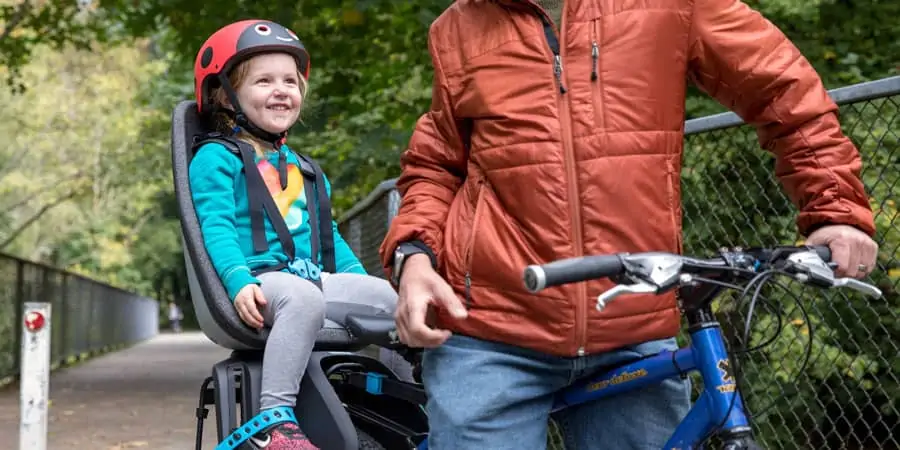
No products found.
Deciding to take your baby out in public and around others for the first time is pressing and worrisome, especially for first time parents.
The biggest concern when strapping a baby for a bike ride is the age factor.
When is the best time for yourbaby’s debut?
In general, it’s 9 to 12 months. It’s at this age babies develop the neck strength needed for supporting the weight of their helmet.
Also, around this time, the neck is usually developed enough to keep the head from bobbing, especially when riding on the uneven terrain.
However, it’s not always so much about the question of age, but more of physical development.
As with all things in parenting and babies, there’s a wide range of normal. Some babies will gain stronger necks from the start, while others will take time.
The development of infants varies quite a lot as to the age in which they can sit up unaided.
But generally, as we’ve mentioned above, this is usually about nine months.
Now, when it comes to the choice of the passenger seat for babies, understand most of the infants find the riding motion so soporific, and they might even nod straight away.
And when they do, they’re likely to slump forward with their head slouched. It’s an uncomfortable position, but it doesn’t harm the baby.
To avoid the discomfort, we suggest you get a seat with a reclining backrest that can adjust to the kid’s sloping.
At What Age Can a Child Ride in an Electric Bike Seat?
![Woman and kid in bicycle trip. Woman nd her child in bicycle helmet. Ride on bike with child seat Best Electric Bike with Child Seat in [current_date format='Y'] 12](https://www.electricridelab.com/wp-content/uploads/2021/01/20780356-scaled.webp)
According to the recommendations of the American Academy of Pediatrics, you should wait till your child is at least 12 months old.
This is because babies younger than 12 months might not have yet developed the neck strength required to support the weight of a helmet (Source). They also will not be able to prevent their head from bobbing around when riding over a bumpy path.
Although when searching for an electric bike with a child seat, you’ll quickly notice that most of the seats designed for your little nugget are rated as safe for infants as young as 9 months old. However, in my opinion, a safety rating is just a technicality.
I would suggest you to err on the side of caution and wait until your child is at least 12 months old. However, if you’re itching to start riding with your child sooner, you should look at other options for hauling babies — such as bike trailers.
Is It Legal To Carry Your Child in a Bike Seat on An Electric Bike?
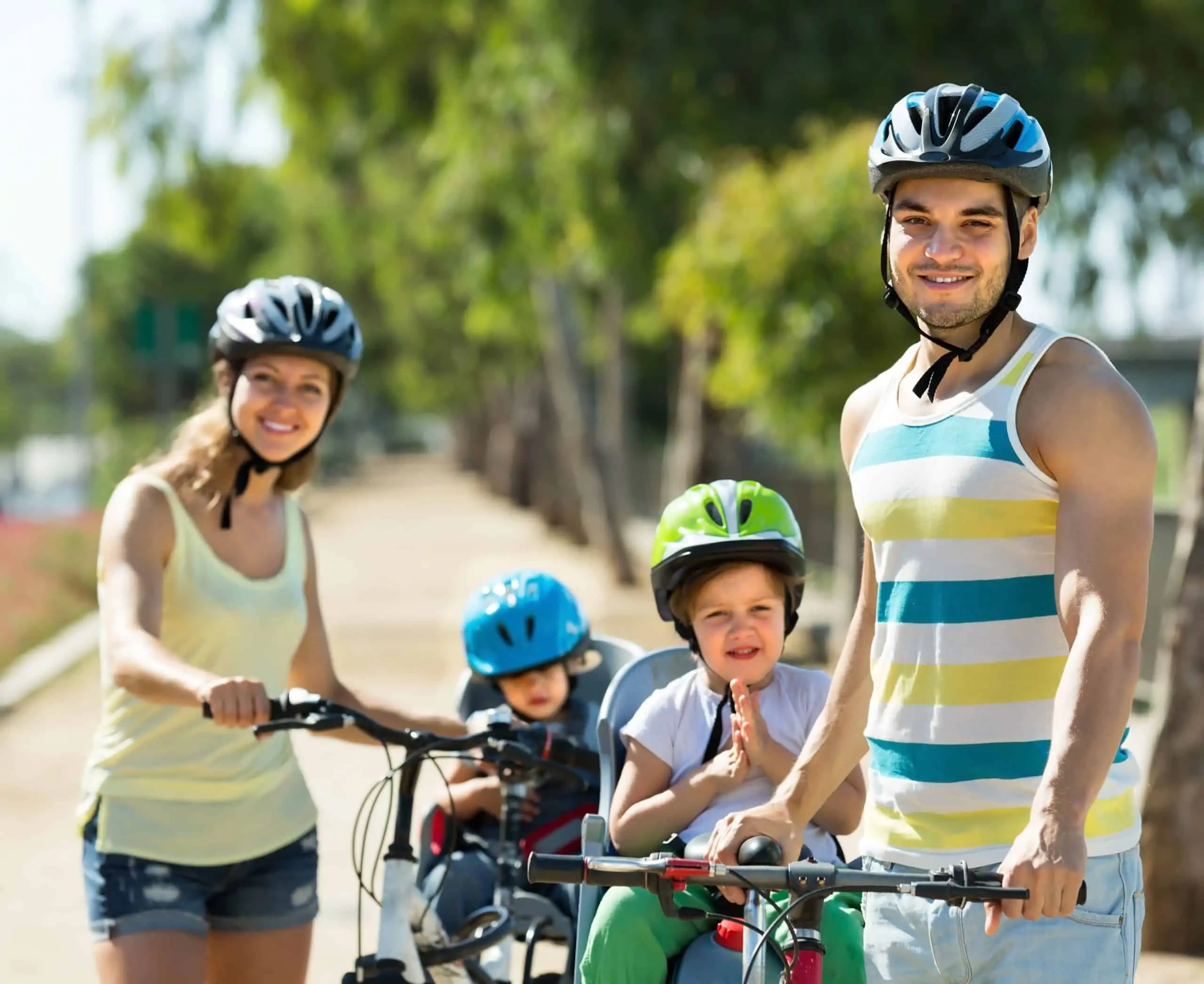
In some states, 12 months is the minimum age your baby has to be before you can carry him around in a child seat on an electric bike, whereas in other states the minimum requirement is 9 months. Some areas also require all kids to wear a helmet.
When it comes to laws regarding electric transport vehicles, most of the states are still playing catch up. What is allowed in one state might be illegal in the other. These laws are also constantly changing. What might be legal today might not be allowed after a few months.
So before purchasing an electric bike with a child seat, to ride around on with your baby, make sure you go through the laws of your area. Although these laws are not often enforced, it’s best you exercise caution and stay on the safe side.
What Are The Different Types of Child Seats for Electric Bikes?
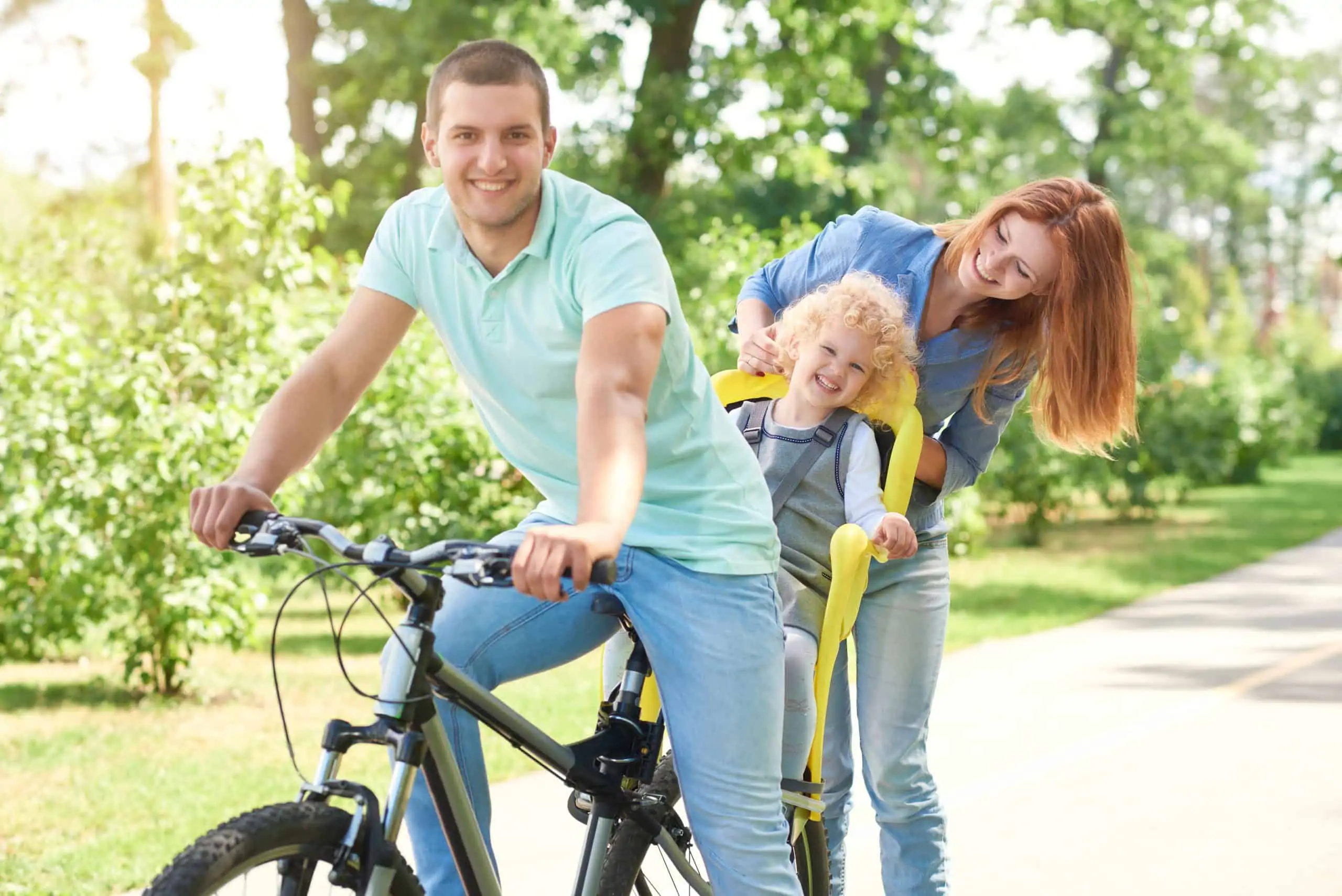
When looking for an electric bike with a child seat, you’ll be faced with two options. The front mounted child seat and the rear mounted child seat. Depending on your requirements, you might prefer one over the other.
Front Mounted Child Seat
The front mounted child seat is either attached to the top tube or to the stem of your electric bike by a small bracket.
If you will be going on a lot of off road adventures with your baby — or just riding on uneven paths — an electric bike with a front mounted child seat might be the perfect option for you.
Riding an electric bike with a front mounted child seat will also offer a more engaging riding experience for your little nugget. Your child would not only be able to see the path ahead, feel the wind hit his face, but will also be able to easily interact with you. You’ll also feel safer having your baby in between your arms.
Additionally, riding an electric bike with a child seat mounted in the front feels much more stable. This is because the weight of the rider is where it’s meant to be – in the center.
However, depending on how big your child is, you’ll find yourself riding with your knees pushed out. Thus, making long rides slightly uncomfortable.
Rear Mounted Child Seat
A rear mounted child seat — as the name suggests — is a seat that is mounted to the back of your electric bike. They’re usually clamped around the seat post of your e-bike or attached to the rear rack.
An electric bike with a rear mounted child seat is much better for longer commutes; since you can comfortably ride without pushing your knees out — which is the downside of an e-bike with a child seat in the front.
They’re also great for riding in windy weather conditions since your body blocks the cold wind from directly hitting your child. And you don’t have to worry about bugs getting in your little ones’ eyes either.
However, compared to front mounted child seat e-bikes, they don’t keep your baby as engaged. Since your body blocks their vision, they can’t really feel or see much of what’s going on. In fact, you’d quite often find your little one asleep in the child seat when you look over your shoulder.
Additionally, rear mounted seats also add a lot of weight to the back of your electric bike. This can potentially upset the balance of your e-bike, and can even result in the front wheel sliding out on loose terrain. Therefore, electric bikes with child seats mounted in the rear are not a good fit for off roaders.
Also Related:
Best eBike Seats | Top 4 Amazing Picks of 2024
Which Electric Bike Child Seat Should You Get?
![Happy family riding bike at the park Best Electric Bike with Child Seat in [current_date format='Y'] 13](https://www.electricridelab.com/wp-content/uploads/2021/01/shot-happy-parents-cuddling-with-their-baby-while-cycling-rollerblading-together-park-love-family-affection-parenting-childhood-emotions-active-lifestyle-scaled.webp)
If your baby is 2 years old or younger, an electric bike with a front mounted child seat will be a more enjoyable experience for both you, and your child. But if your little munchkin is 2.5 years or older, you’ll find a rear mounted child seat more comfortable.
Additionally, for off roading and shorter commutes, you’ll feel safer having your child in between your arms. And so, going for a front seat will be a better option. However, for longer commutes on paved roads, an electric bike with a child seat at the back will offer a more pleasant ride.
Longevity is another thing you should keep in mind when deciding on an electric bike with a child seat. Your toddler will quickly outgrow front mounted seats because they’re smaller in size. So, if you only want to make a single purchase, go for a rear seat electric bike.
Can You Carry Two Kids on An Electric Bike with a Child Seat?
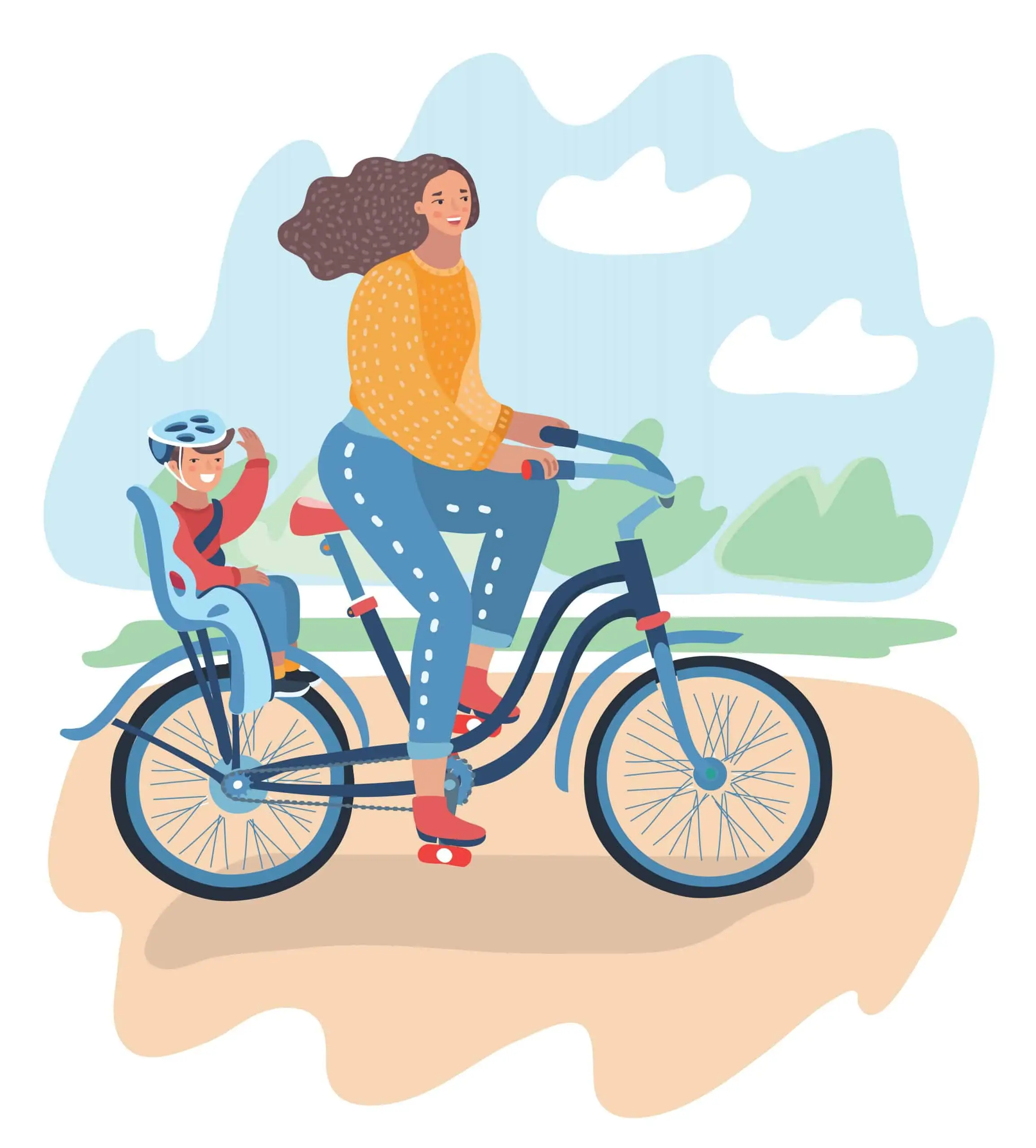
To put it simply, yes. It’s definitely doable.
By fitting both a front mounted child seat and a rear mounted child seat to your electric bike, you can haul both your kids around at once. The younger one can go in the front seat whilst the older one sits in the rear seat.
Although you would not feel the added weight while riding — due to the motor of your e-bike powering you forward — you will definitely find maneuvering your child seat electric bike difficult.
So if you are new to riding electric bikes, practice with only one of your munchkins first, before adding the second. And only go out on the road after you’ve got the hang of it. You should also install a kickstand on your electric bike; this will allow you to easily load your kids.
What is the Maximum Weight for an Electric Bike Child Seat?
On average, a 24 month old child weighs around 26 pounds according to the World Health Organization. This means you won’t run into problems hauling your baby around in an electric bike with a front mounted child seat till the age of 2.
On the other hand, a rear mounted child seat can bear more weight; usually around 45 pounds. This means as your child gets heavier with age, you’d have to switch from a front seat to a rear seat.
What Other Features Should You Consider When Getting a Child Seat Electric Bike?
I’ve already covered the most important things you need to keep in mind when getting an electric bike with a child seat. However, there are a couple of other tiny features you can also take into account before making a decision.
Shoulder Straps
Ensuring that your electric bike child seat comes with shoulder straps is very important. Especially for rear mounted baby seats. You can tightly strap your little one in his place and not worry about him falling off.
If you want something more comfortable for your baby, you should get child seats with padded shoulder straps. Not only are they a more comfortable option, but they’re also more secure, and tend to stay in place better.
Reclining Seats
By getting an electric bike with a reclining child seat, you don’t have to worry about your baby being uncomfortable if he falls asleep. This is especially important if you’d be going on long commutes with your child.
However, you’ll only find this option on high-end, rear mounted child seat electric bikes.
Adjustable Footrests with Straps
Another feature you might find important are adjustable footrests with straps. They not only give your toddler a secure place to rest their feet on, but also prevent them from kicking and swinging. After all, you wouldn’t want to be kicked in the back by your baby while you’re riding.
Frequently Asked Questions
-
What are the top electric bikes with child seats in 2023?
The top electric bikes with child seats in 2023 are RadRunner 2, Aventon Level, and Radwagon 4.
-
Is it safe to carry a child in a bike seat on an electric bike?
Yes, it’s safe to carry a child on an electric bike’s seat as long as necessary precautions are taken. This includes strapping them securely in their seats, maintaining low speeds, ensuring the seat is designed for heavy-duty purposes, and considering the installation of guards around the seat area.
-
At what age can a child ride in an electric bike seat?
According to the American Academy of Pediatrics, it’s recommended to wait until a child is at least 12 months old before they ride in an electric bike seat. This is due to the need for neck strength to support the weight of a helmet and to prevent head bobbing on bumpy paths.
-
Is it legal to carry a child in a bike seat on an electric bike?
The legality varies by state. In some states, the minimum age is 12 months, while in others it’s 9 months. Some areas also require children to wear helmets. It’s essential to check the local laws before carrying a child on an electric bike.
-
What are the different types of child seats for electric bikes?
There are two main types of child seats for electric bikes: front-mounted and rear-mounted. Front-mounted seats are attached to the top tube or stem of the bike and are ideal for children aged 9 months to 2.5 years. Rear-mounted seats are attached to the back of the bike, either clamped around the seat post or attached to the rear rack, and are suitable for children aged 12 months to 48 pounds.
-
Which electric bike child seat should I choose?
For babies and toddlers up to 2 years old, a front-mounted seat offers a more engaging experience. For children aged 2.5 years and older, a rear-mounted seat might be more comfortable. The choice also depends on the type of riding (off-road vs. paved roads) and the duration of the rides.
-
What features should I consider when getting a child seat electric bike?
Some features to consider include shoulder straps, reclining seats, adjustable footrests with straps, and the overall weight capacity of the bike and seat.
-
How do I ensure the safety of my child while riding?
Always strap them securely in their seats, maintain speeds below 15mph, ensure the seat is designed for heavy-duty purposes, and consider installing guards around the seat area. Always prioritize the child’s safety and comfort.
-
Are there any drawbacks to using front-mounted child seats?
Yes, with front-mounted seats, riders might find themselves riding with their knees pushed out, making long rides slightly uncomfortable. Additionally, children might outgrow front-mounted seats faster.
-
What are the benefits of rear-mounted child seats?
Rear-mounted seats are more comfortable for longer commutes, protect the child from direct wind, and offer more space for the child. They also allow the child to sleep comfortably during the ride.
-
What are the benefits of a front-mounted child seat on an electric bike?
front-mounted child seat offers a more engaging riding experience for the child as they can see the path ahead, feel the wind on their face, and easily interact with the rider.
The child is placed directly between the rider’s arms, offering a sense of security.
Riding an electric bike with a front-mounted child seat feels more stable as the weight of the child is centered. -
What are the drawbacks of a front-mounted child seat?
Depending on the size of the child, the rider might find themselves riding with their knees pushed out, making long rides uncomfortable.
-
What are the benefits of a rear-mounted child seat on an electric bike?
Rear-mounted child seats are more suitable for longer commutes as the rider can pedal comfortably.
The rider’s body shields the child from wind and potential debris, offering added protection.
Rear-mounted seats can be more spacious and offer features like reclining seats and adjustability. -
What are the drawbacks of a rear-mounted child seat?
The child’s vision might be obstructed by the rider’s body, making the ride less engaging for them.
Rear-mounted seats add significant weight to the back of the electric bike, potentially affecting its balance. -
Which electric bike child seat is recommended for younger children?
For children aged 2 years or younger, a front-mounted child seat is recommended as it offers a more engaging experience for the child and feels safer for the rider.
-
Which electric bike child seat is recommended for older children?
For children aged 2.5 years or older, a rear-mounted child seat is more suitable due to its comfort and additional features.
-
Are there any legal considerations when carrying a child in a bike seat on an electric bike?
The legal age for carrying a child in a bike seat varies by state, with some states requiring a minimum age of 12 months and others 9 months. Additionally, some areas mandate that children wear helmets. It’s essential to check local laws before riding with a child.
-
How do I ensure the safety of my child while riding on an electric bike?
Always strap the child securely in their seat.
- Maintain low speeds, preferably below 15mph, when traveling with a child.
- Ensure the child’s seat is designed for heavy-duty purposes and adheres to the weight capacity recommendations.
- Consider installing guards or safety mechanisms around the child seat area.
-
What is the recommended age for a child to ride in an electric bike seat?
The American Academy of Pediatrics recommends waiting until the child is at least 12 months old before allowing them to ride in an electric bike seat. This is to ensure the child has developed sufficient neck strength to support a helmet and prevent their head from bobbing on uneven paths.


